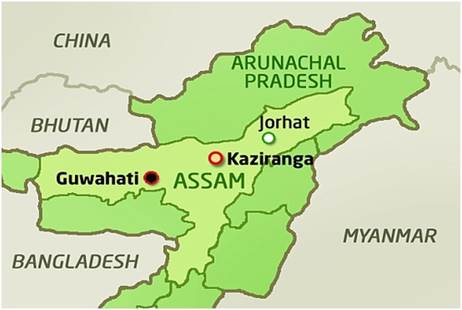Why in news?
- The COVID-19 lockdown has activated poachers who had been forced into lying low for more than a year.
- At least six thwarted attempts have been made within a week in and around Assam’s national parks.
- The lockdown has inadvertently made it easier for the poachers by thinning the ranks of the network of local people who had hitherto been a critical part of the anti-poaching campaign by tipping off forest officials on any suspicious movements near the parks.
- Lockdown appears to have given rhino poachers free time to regroup and plan strikes in Kaziranga after more than a year, they know there will be demand for rhino horns in China and other consumer countries in Asia after the pandemic-induced slump is over.
- The International Rhino Foundation has insisted that China, Vietnam and other countries must do more than merely banning wildlife trade temporarily.
Why such a demand for Rhino Horns?
- The rhino horn trade is driven by the demand for rhino horn in Asian countries, particularly Vietnam.
- Rhino horn is used in Traditional Chinese Medicine, but increasingly common is its use as a status symbol to display success and wealth.
- Besides rumours that it can cure people of COVID-19 also exist.
- However, a rhino horn is nothing but dead keratin cells, similar to human hair and nails.
Rhinos in Asia and India
- There are three species of rhino in Asia — Greater one-horned, Javan and Sumatran. Javan and Sumatran Rhino are critically endangered and the Greater one-horned (or Indian) rhino is vulnerable In IUCN Red List.
- They are spread across India, Nepal, Bhutan, Indonesia and Malaysia. These countries are also known as Asian Rhino Range Countries.
- Only the Great one-horned rhino is found in India.
- At present, there are about 2,600 Indian rhinos in India, with more than 90% of the population concentrated in Assam’s Kaziranga National Park.

Projects in India for conservation of Rhinos
Indian (One Horn) Rhino Vision 2020
- Indian rhino vision 2020 implemented by the department of environment and forests, Assam.
- The programme will be supported by WWF — India, the international rhino foundation (IRF), and a number of local NGOs.
- Translocations are the backbone of the IRV 2020 program.
- The goal set was to populate the potential rhino habitat areas identified viz. Manas NP, Dibru Saikhowa WLS, Laokhowa-Bura Chapori WLS with a viable population of rhino through translocations from Kaziranga NP and Pobitora WLS.
- Manas National Park was selected as the first site for translocation of rhinos.
- Ten rhinos have been released into Manas since 2008. Ten more rhinos will be moved from Kaziranga National Park before the end of the year.
- The vision of this program is to increase the total rhino foundation in Assam from about 2000 to 3000 by the year 2020 and to ensure that these rhinos are distributed over at least 7 protected areas (PA) to provide long term viability of the one-horned rhino population.
- Concentrating so many rhinos in a single protected area like Kaziranga exposes the species to risks of calamities (epidemics, floods, massive poaching attempts).
National Rhino Conservation Strategy
- It calls for active engagement between India and Nepal to conserve the Greater one-horned rhinoceros.
- The plan said the single population of rhinos in Sukla-Phanta (Nepal), Valmiki Tiger Reserve (India) and Chitwan National Park (Nepal) and Dudhwa (India) is separated by the political boundary between the two countries.
- It asks for the management of the two population under the same protocol, instead of managing the two population separately.
- The plan calls for expanding distribution range as the occurrence of 90% of the rhino in one protected area is a cause of concern and conservation of existing and potential rhino habitats need to be made a national priority.
Facts about Kaziranga National Park

- Kaziranga National Park is one of India’s oldest reserve areas, located in Golaghat and Nagaon, in Karbi Anglong districts of Assam in northeast India.
- Mary Curzon took the initiative to declare the area ‘protected’ with her husband Lord Curzon after she failed to spot a single rhinoceros.
- In 1905, the Kaziranga Proposed Reserve Forest was established. In 1950, the area was renamed Kaziranga Wildlife Sanctuary.
- In 1974, the Indian government gave the park official status.
- In 1985, the national park was designated a UNESCO World Heritage Site.
- Kaziranga is home to 2/3rd of the world’s population of rhinoceroses. In 2006, the park was declared a Tiger Reserve. It has one of the highest density of tigers in the world.





